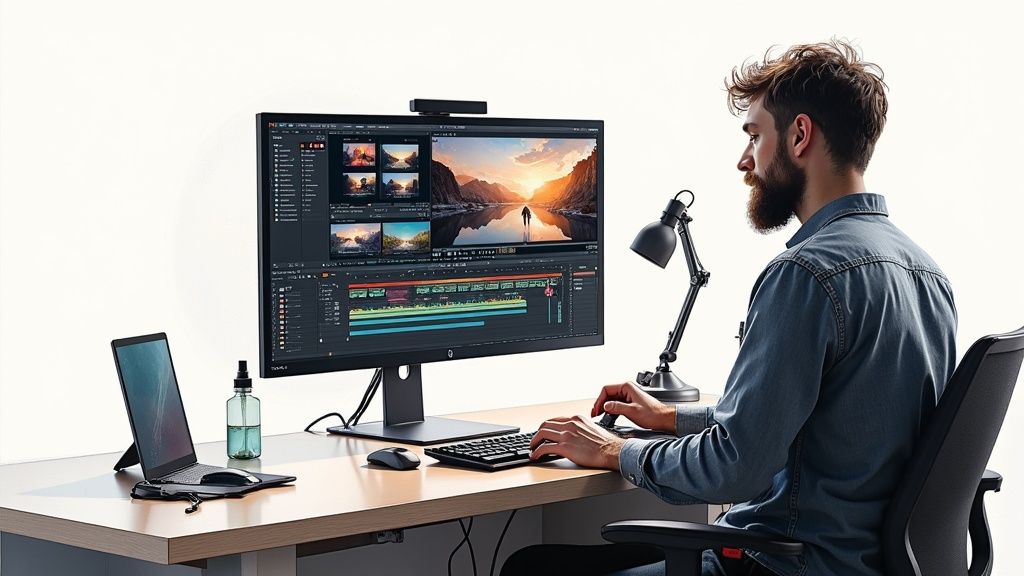The Evolution of Video Production Workflow

The video production world has changed dramatically. Traditional linear workflows are fading, replaced by more agile processes. This shift is fueled by the growing demand for video and the need for quicker turnarounds. Production teams must balance quality with creating more content using fewer resources.
From Waterfall to Agile: Adapting to Change
The rigid, sequential "waterfall" method is being replaced by flexible, iterative approaches. Companies like Netflix and HubSpot have adopted agile methodologies, allowing them to respond to changing project needs and market trends. This adaptability is essential in today's fast-paced media landscape. For more on video project management, check out this helpful resource: How to master video production project management with tactics.
The Rise of In-House Production and AI
The video production landscape in 2025 revealed interesting budget and workflow trends. Almost half of companies worldwide spent less than $5,000 annually on video production. Over a third spent more than $5,000, integrating video budgets into broader marketing strategies. Only 5% of companies decreased video budgets, while over half increased investments. This reflects the growing importance of video for engagement and brand building.
In-house production is also on the rise. 75% of companies rely on internal teams, while 25% outsource. This shift aligns with cost-efficiency goals, as seen with AI-powered workflows. Companies like Teleperformance are saving $5,000 per video using AI. More statistics can be found here: Video Marketing Statistics.
Core Components of a Modern Workflow
Regardless of budget or team size, several key components contribute to an efficient video production workflow:
-
Clear Communication: Open communication among all stakeholders is essential.
-
Defined Roles and Responsibilities: Each team member needs a clear understanding of their role.
-
Efficient Project Management: Project management tools and strategies are vital for organization and scheduling.
-
Flexible Frameworks: Adaptability is crucial for navigating changing project requirements and deadlines.
These core elements ensure a smooth video production process, from pre-production to distribution, delivering high-quality results. This adaptability is essential in meeting the ever-evolving needs of modern video production.
Pre-Production: The Foundation of Exceptional Content
Creating high-quality video content requires careful planning. Thorough pre-production is the key differentiator between amateur and professional projects. It sets the stage for a smooth production process, ensuring your video not only looks polished but also achieves its intended purpose. This crucial first step is where creative vision meets practical execution.
Defining Your Vision and Scope
Before cameras roll, understand your video's objectives. Ask yourself: What message are you trying to convey? Who is your target audience? These questions will guide every subsequent decision in your planning process.
Defining the project scope, including budget and timeline, is equally important. This establishes realistic expectations and avoids costly changes mid-project. Everyone involved should be on the same page from the outset. For a deeper dive into engaging content creation, check out this helpful guide: How to create engaging content - A complete guide that drives real results.
The Creative Brief: Your Project Roadmap
The creative brief is the project's roadmap. It outlines the video's core message, target audience, desired style, and key performance indicators (KPIs). This document acts as a blueprint, guiding every stage of production, from scripting to post-production.
For example, a creative brief for a product demo video might specify the product's key features, the target audience's needs, and the desired tone (informative, humorous, etc.). This ensures everyone is aligned on the creative vision.
Scheduling and Resource Allocation
A realistic production schedule is vital for staying on track and within budget. Break down the project into manageable tasks, assign deadlines, and allocate resources effectively. A well-structured schedule ensures all elements of the production workflow operate in sync.
Shot Lists and Storyboards: Visualizing Your Story
Shot lists and storyboards help you visualize your story before filming. A shot list details every shot required, while a storyboard provides a visual representation of the sequence. This pre-visualization streamlines production, ensuring the crew captures all necessary footage efficiently. It also provides an opportunity for creative problem-solving before filming begins.
To ensure thorough planning, review your pre-production efforts against the following checklist components. The table below details the purpose, timeline, and resources required for each element.
Pre-Production Checklist Components: Essential elements to include in your pre-production planning phase
| Pre-Production Element | Purpose | Timeline | Resources Required |
|---|---|---|---|
| Concept Development | Define video purpose, target audience, key message | Initial planning stage | Creative team, research materials |
| Creative Brief | Document project scope, style, desired outcomes | After concept development | Creative team, client input |
| Budget Allocation | Outline estimated costs for each production phase | Before production begins | Production manager, financial resources |
| Production Schedule | Create detailed timeline with tasks and deadlines | After budget approval | Production manager, team input |
| Shot List/Storyboard | Visualize video sequence and individual shots | During pre-production | Director, storyboard artist |
| Location Scouting | Identify and secure suitable filming locations | During pre-production | Location manager, resources |
| Talent/Crew | Confirm availability and secure contracts | During pre-production | Production manager, casting director |
| Equipment Checklist | Ensure all necessary equipment is available and functioning | Before filming begins | Equipment manager, resources |
| Legal/Permissions | Obtain necessary permits and releases | As needed, before filming | Legal team, resources |
This checklist ensures a smooth and efficient production process. By addressing each element, you minimize potential issues and maximize the impact of your video.
By meticulously planning each stage of pre-production, you create a solid foundation for a successful and impactful video. This upfront investment prevents costly mistakes, maximizes efficiency, and ultimately delivers exceptional content that resonates with your audience.
Production Phase: Capturing Content That Connects

The production phase is where all that careful pre-production planning finally comes to life. It's where the real work begins in the video production workflow. This section dives into practical techniques seasoned directors and cinematographers use for efficient, smooth production days.
Technical Setup and Bottleneck Prevention
Efficient equipment setup is key for a productive shoot. A well-organized technical setup minimizes downtime and keeps the video production workflow moving. This means having all your gear ready, tested, and configured. Simple things like backup batteries and extra memory cards can prevent frustrating delays.
Anticipating potential bottlenecks is also crucial. Think about things like power supply and data storage. Addressing these logistical challenges beforehand saves valuable filming time and prevents costly overruns. A streamlined technical setup keeps the creative team focused on capturing compelling content.
Lighting and Audio: Quality and Efficiency
Lighting dramatically impacts the visual quality of your video. Efficient lighting setups not only improve the final product but also save time. Techniques like three-point lighting can create a professional look efficiently.
High-quality audio is just as important. Clear audio elevates the viewing experience and avoids costly reshoots or ADR (Automated Dialogue Replacement). Using the right microphones and monitoring audio levels throughout the shoot ensures clean, usable audio.
Maintaining Momentum and Troubleshooting
Keeping creative momentum during long shoots is a challenge. Experienced production teams use several strategies to keep energy high. Regular breaks, a positive on-set atmosphere, and clear communication contribute to a productive and energized team.
Unexpected challenges are bound to happen during production. Equipment malfunctions, weather changes, or talent availability can disrupt the workflow. Contingency plans and a flexible mindset are essential for adapting and overcoming these obstacles.
Quality Control and Role Allocation
Quality control checkpoints throughout production catch potential issues early. Regularly reviewing footage helps prevent small problems from becoming big (and expensive) problems in post-production.
Clearly defined roles and responsibilities also ensure a smooth workflow. Whether it's a small crew or a large team, assigning specific tasks avoids confusion and streamlines the process. Clear delegation empowers team members and creates a cohesive, productive environment, optimizing the entire video production workflow.
Post-Production: Transforming Footage Into Impact

Post-production is where raw video footage transforms into a polished final product. This crucial stage can truly make or break a project. This section helps you navigate the complexities of post-production, breaking it down into manageable steps.
Structuring Your Editing Pipeline
A structured editing pipeline is essential for optimizing post-production. Just like a factory assembly line, a well-defined workflow streamlines the process. This begins with organizing your footage. Think of it as prepping ingredients before cooking – having everything in place saves valuable time.
A strong pipeline also balances efficiency and creativity. It's not just about speed; it's about maximizing the creative potential of your footage within a practical framework. This balance allows you to meet deadlines without compromising quality.
Footage Organization and Version Control
Organized footage is key to avoiding version control issues. A practical system for labeling and storing files ensures easy access to the right clips. This prevents wasted time searching for specific shots, maintaining a smooth workflow. Imagine building a house with disorganized blueprints – chaos would quickly ensue. Similarly, disorganized footage hinders the editing process.
Feedback Loops and Revision Cycles
Minimizing revisions through effective feedback loops is crucial. Clear communication between the editor, client, and stakeholders ensures everyone is aligned. This involves setting clear expectations and providing constructive, specific feedback.
Collaborative review platforms, for example, allow stakeholders to add time-coded comments directly to the video. This precise feedback reduces misunderstandings and streamlines revisions, saving both time and resources. Brands are constantly seeking ways to optimize this process. By 2025, U.S. video ad spend is projected to reach $130.97 billion, highlighting the increasing importance of efficient video production. Learn more about these trends.
Quality Assurance and Technical Delivery
Quality assurance is the final checkpoint, ensuring your video meets technical standards. This includes checks for correct resolution, audio levels, and proper formatting for various platforms. This meticulous approach guarantees a professional, distribution-ready final product.
Color Grading, Sound Design, and Graphics Integration
Color grading sets the mood and visual style, reinforcing brand identity across campaigns. Sound design adds emotional depth and production value, immersing the viewer. Graphics integration, such as lower thirds or animations, reinforces key messages concisely. These finishing touches elevate a video from good to exceptional.
Optimizing Post-Production With Technology
A strong tech stack can significantly enhance post-production. Software with features like AI-powered noise reduction, automated transcription, and cloud collaboration tools can greatly reduce manual work. This allows editors to focus on the creative aspects, rather than tedious technical tasks.
To help illustrate the variety of video editing software available, let's look at a comparison of a few popular platforms. The table below highlights their strengths and weaknesses for various production needs and team sizes.
Video Editing Software Comparison: Comparison of popular video editing platforms for different production needs and team sizes
| Software | Best For | Learning Curve | Key Features | Pricing Model |
|---|---|---|---|---|
| Adobe Premiere Pro | Professional editors, complex projects | Steep | Advanced editing tools, extensive effects, industry-standard | Subscription |
| Final Cut Pro | Mac users, high-quality productions | Moderate | Powerful editing tools, optimized for Apple hardware | One-time purchase |
| DaVinci Resolve | Color grading, professional workflows | Moderate to Steep | Industry-leading color correction, advanced editing features | Free and paid versions |
| Filmora | Beginners, simple projects | Easy | User-friendly interface, basic effects and tools | Free and paid versions |
| iMovie | Mac and iOS users, basic editing | Easy | Simple interface, free for Apple users | Free |
As you can see, selecting the right software depends greatly on your project's scope, your budget, and your team's technical expertise. From simple edits to complex productions, there's a tool that fits your needs.
Distribution Strategy: Ensuring Your Videos Get Seen
A finished video isn't the final step; it's just the beginning of its journey to your audience. Even the most captivating content can fail to reach its potential without a strong distribution strategy. Savvy brands understand this, weaving distribution planning into every stage of video production.
Platform-Specific Optimization: Reaching the Right Audience
Every platform has its own unique audience and technical requirements. A video perfectly formatted for YouTube might not perform well on TikTok. Platform-specific optimization means tailoring your video's format, length, and style to suit each platform.
-
YouTube: Prioritize SEO with strong titles, detailed descriptions, and relevant tags. Longer videos often thrive on this platform.
-
TikTok: Short, attention-grabbing content reigns supreme. Use trending sounds and relevant hashtags to boost visibility.
-
Instagram: Focus on high-quality visuals and engaging Stories. Use Instagram Reels for short, impactful content.
-
Facebook: Foster community engagement and create shareable content. Consider using Facebook Live for real-time interaction.
Understanding the nuances of each platform allows you to maximize your video's reach and impact.
Publishing Schedules and Audience Engagement
Timing is everything. A strategic publishing schedule maximizes audience engagement. Analyze your target audience's online behavior. When are they most active online? What days do they watch the most videos? This data informs your publishing strategy, ensuring your content is seen when your audience is most receptive.
Consistency is key. A regular publishing schedule keeps your audience engaged and anticipating new content.
Metadata and Discoverability
Metadata, including titles, descriptions, and tags, plays a crucial role in video discoverability. These elements provide context for search engines and platform algorithms, helping viewers find your content. Accurate and relevant metadata significantly boosts your video's visibility in search results and platform recommendations.
Tracking Performance: Beyond Vanity Metrics
Measuring the effectiveness of your distribution strategy involves looking beyond superficial metrics like views and likes. While these vanity metrics provide a glimpse of surface-level performance, they don't tell the whole story. Audience retention, conversion attribution, and engagement benchmarks offer a more comprehensive understanding of viewer behavior. High audience retention, for example, suggests that viewers find your content compelling. By tracking these metrics, you can identify what resonates with your audience and refine your strategy for future videos. Implementing tracking systems from the start allows you to analyze this valuable data and create a continuous improvement cycle within your video production process.
Building Your Production Tech Stack

The technology you choose for video production significantly impacts your final product and overall efficiency. It's not about buying the priciest software, but about selecting the right tools for your needs and integrating them smoothly. This section explores building a tech ecosystem that empowers your team without added complexity.
Essential Tools for Every Stage
Different video production stages benefit from specific tools. Pre-production relies on project management and communication software like Asana or Slack. Production uses cameras, lighting, audio equipment, and specialized gear like gimbals or drones. Post-production relies on editing software like Adobe Premiere Pro, color grading tools, and audio mixing programs. Choosing the right tool for each phase elevates quality and efficiency.
Criteria for Selecting the Right Technology
Choosing the right technology involves several factors. Budget is a primary concern, but not the only one. User-friendliness affects your team's learning curve. Compatibility between software and hardware is crucial for smooth workflows. Scalability is also important; your tech stack should grow with your production needs.
Integration and Automation: Minimizing Friction
Integration streamlines the video production workflow. For example, cloud-based project management software can integrate with your editing software for seamless file sharing and feedback. Automation also reduces repetitive tasks. Automated transcription services, like Otter.ai, free your team from manual transcription.
Cloud-Based Solutions for Enhanced Collaboration
Cloud-based solutions are vital, especially for remote or hybrid teams. Cloud storage, such as Google Drive or Dropbox, allows easy access to project files from anywhere. Cloud-based editing software enables multiple team members to work simultaneously, speeding up production.
Building a Scalable Tech Ecosystem
A scalable tech ecosystem adapts to your needs. As your team or output grows, your technology should too. This might mean upgrading software, increasing storage, or adding automation tools. Think of your tech stack as adaptable and evolving alongside your changing production requirements. A flexible tech stack meets rising demands without sacrificing quality or efficiency.
Optimizing Your Tech Stack for Efficiency
Your tech stack should be dynamic. Regularly evaluate its performance and identify any issues. This might involve underutilized software or obsolete hardware. Get team feedback to understand their needs and frustrations. By optimizing your tech stack, you ensure it remains a valuable asset.
Budget-Friendly Tech Stack Options for Startups
Starting video production doesn't require a massive tech investment. Many free or low-cost software options exist, especially for basic editing, graphics, and audio. Cloud-based solutions minimize hardware costs, and open-source software provides cost-effective alternatives. Strategic tool choices allow startups to build a functional tech stack affordably.
By thoughtfully choosing and integrating the right technology, you create an efficient, scalable video production workflow that supports your creative vision.
Scaling Your Video Production Without Breaking
As video's importance in marketing continues to grow, so does the need for more content. This presents a challenge: how can you scale your video production workflow without sacrificing quality or overworking your team? It's not just about making more videos; it's about producing more effective videos within a sustainable system.
Template-Based Approaches: Efficiency for Recurring Content
One effective scaling strategy is developing template-based approaches for recurring video types. Think of it like a blueprint – you have a core "design" (template) that you can quickly modify for different projects (content variations). For example, if you regularly create product demos, build a template with a consistent structure: introduction, features overview, benefits, and call to action. This lets you easily swap in new product details, significantly speeding up the video production process.
Building In-House Capabilities: Investing in Your Team
Another powerful scaling tactic is investing in your team’s skill development. Training programs can empower your existing staff to handle more video production responsibilities. This reduces reliance on costly outsourcing and gives you greater control over the whole process. This approach not only improves efficiency but also fosters a culture of continuous improvement within your team. You might be interested in: How to budget your next video project like a pro.
Hybrid Models: Balancing Internal and External Resources
A hybrid model combining in-house production with external resources can offer flexibility and scalability. This approach lets you manage routine video creation internally while using external partners for specialized projects demanding specific expertise, such as high-end animation or complex visual effects. This strategic balance optimizes both cost and creative potential.
Identifying Bottlenecks: Optimizing Your Workflow
Effective scaling requires identifying and addressing workflow bottlenecks. Where does your current process slow down? Are revisions taking too long? Is footage organization a nightmare? Pinpointing these bottlenecks is the first step towards implementing practical solutions.
Incremental Improvements: Compounding Over Time
Small changes can yield big results over time. Implementing incremental improvements in areas like communication, file management, and feedback loops can streamline your workflow. This cumulative effect considerably improves efficiency in the long run.
Building Flexible Systems: Adapting to Change
The key to sustainable scaling is building flexible systems. The video production landscape is always changing, and your workflow needs to adapt to new demands. This includes using agile methodologies, adopting new technologies, and promoting continuous learning within your team.
Maintaining Creative Quality: Scaling Without Compromise
Scaling your video production shouldn't mean sacrificing creative quality. By establishing clear quality control checkpoints throughout the process, from pre-production to distribution, you can ensure every video meets your standards. This commitment to quality strengthens your brand and resonates with your audience.
Ready to scale your video production and unlock its full potential? Aeon, our innovative video creation platform, empowers publishers to transform text, audio, and video content into engaging video formats effortlessly. Streamline your workflow and boost your output with Aeon's AI-powered features. Visit Aeon today and revolutionize your video creation process.